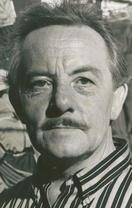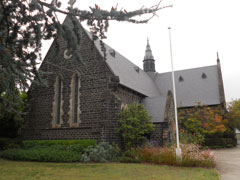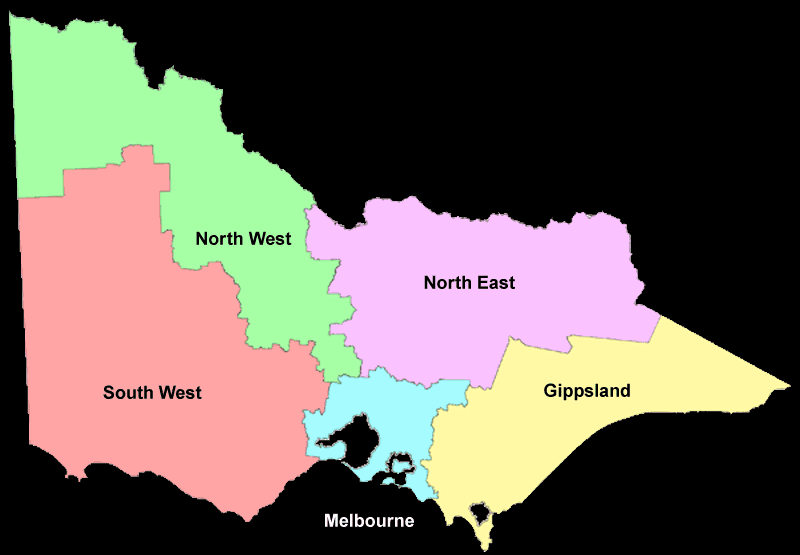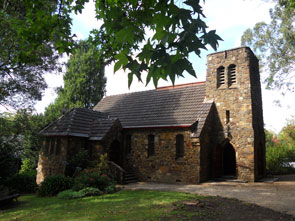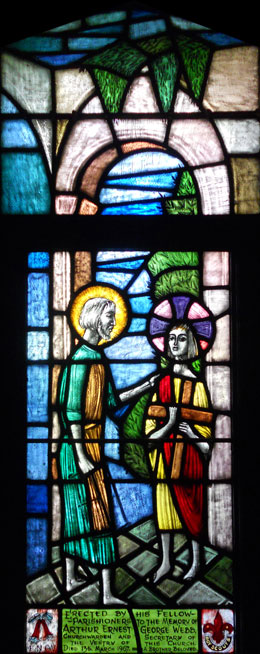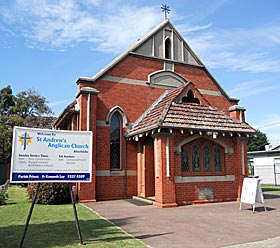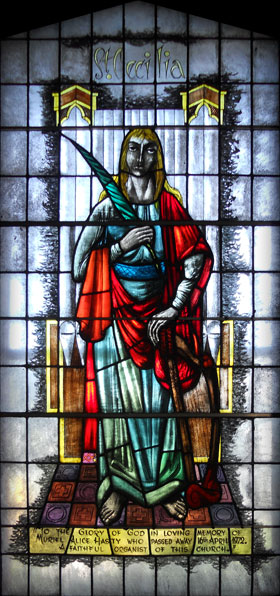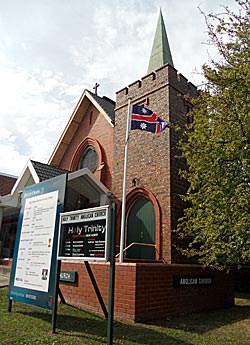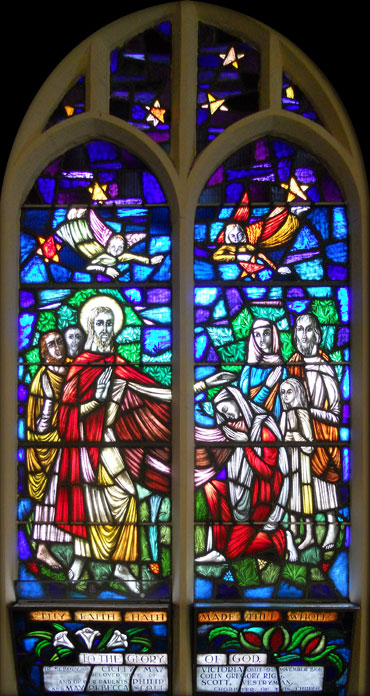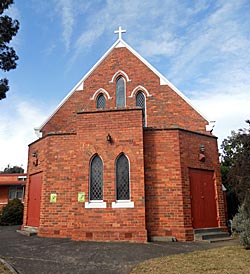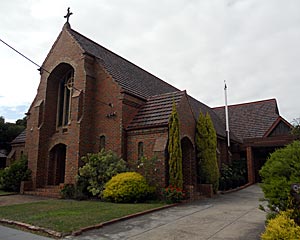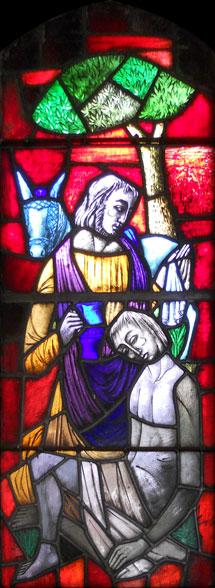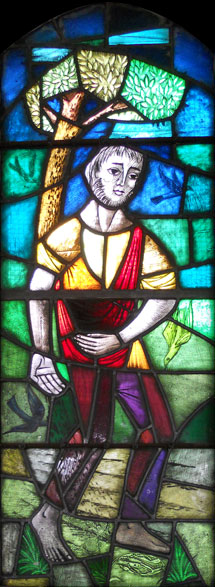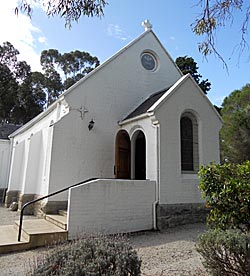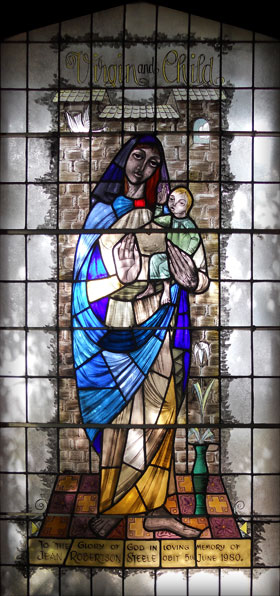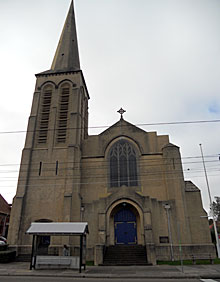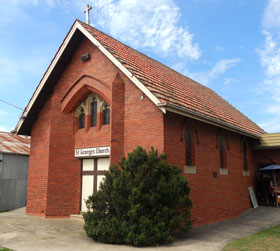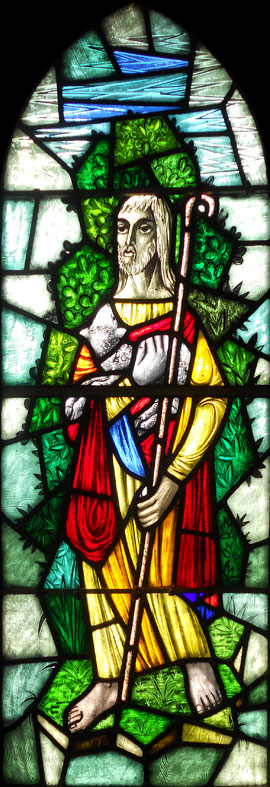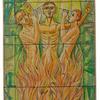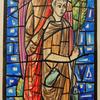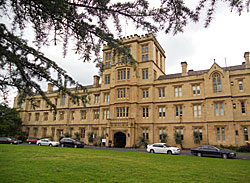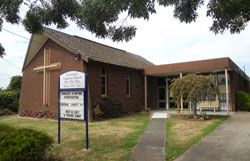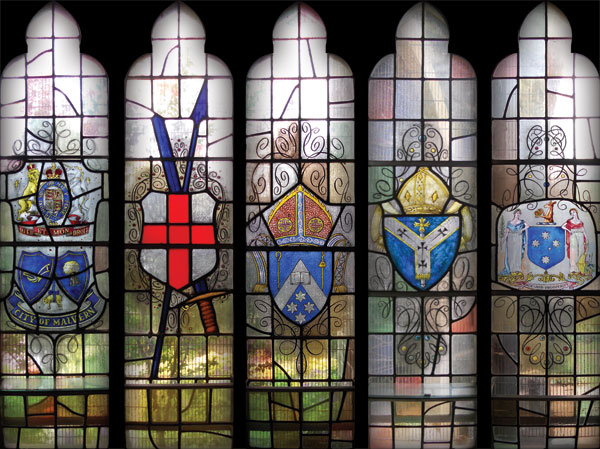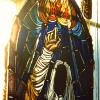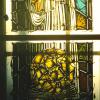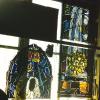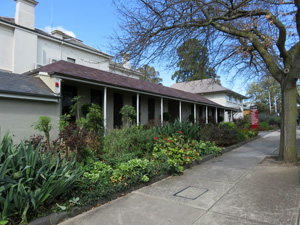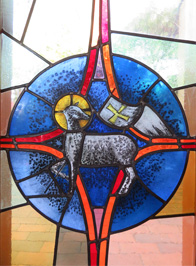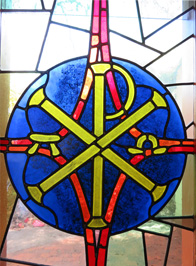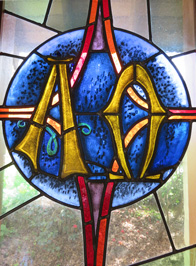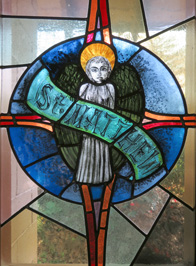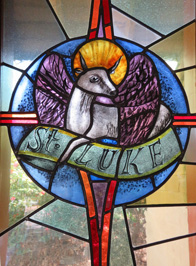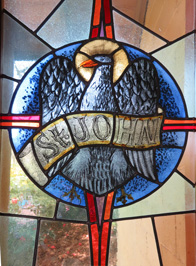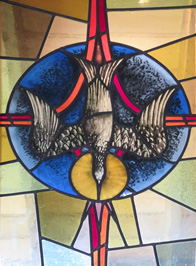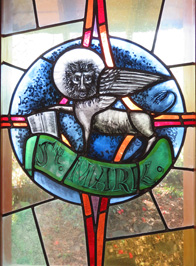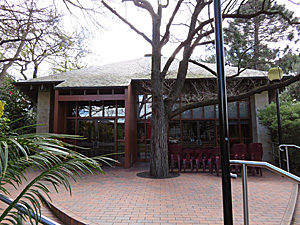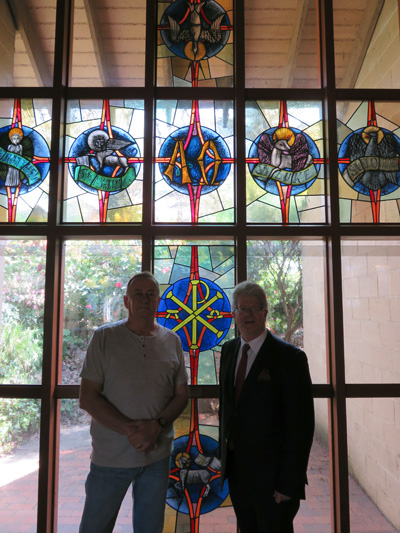All the information contained on this website is from Jean's personal correspondence with his patrons & family,
collated by Noel and Rachael Orval.
Sholl, a Rhodes Scholar, became the Consular General in New York and later, was Chairman of the Chamberlain Innocence Committee and was instrumental in instigating a judicial enquiry into the conviction of Lindy Chamberlain. Jean and Mr Sholl kept up their correspondence and friendship until Jean passed away in 1987.
Jean was approached for 2 windows in December 1965 to feature "St Augustine" and "St Aiden". The Reverend Vicar Stanley Moss and Blyth & Josephine Johnson (architects and town planners) discussed over many months the best way to depict the 2 saints and provided Jean with many pictures and dialogue to help him in his design.
The "St Aiden" inscription was in loving memory of Percy Cotes, his wife Agnes, their sons Charles and Robert and daughter Marjorie. On August 2, 1969, Jean sent the full size drawings to Reverend Moss and described how "I have never been as mixed up about a window as about these ones."
So much information was supplied to try to appease many minds about how the finished product should look. In August, the Reverend Moss gave the go ahead for the windows as depicted by Jean and stated "Both I and Mrs Johnson would like you to know that we both have unshakable confidence in your artistic integrity and ability and that we are looking forward with keeness to the fruits of your present creativity." The dedication for "St Augustine" and "St Aiden" was conducted by Bishop Felix Arnott on November 26, 1969. The "St Augustine" inscription read to Susan and her mother Jean Southcott.
When Jean returned from a study trip to Holland and Germany in 1968, Reverend Moss wrote again to meet concerning 2 new windows for St George's - that of William Tyndale (Bible translator) and Robert Grossteste (Theologian and Bishop).
The gratitude St George's felt for the previous windows prompted them to make a $610 first payment for the new windows before Jean had even composed a sketch. The only other person to have such faith was Mr Norman McAllister of Marnoo for a church window in his church and a private commission in 1966. On January 9, 1969, Jean was given the all clear to proceed, with the inscription being in loving memory of Dorothy Mehrens and Eric Mehrens and their only son Ian. These windows were completed and installed on March 22, 1969 and dedicated by Bishop Arnott on Sunday, June 29, 1969. Reverend Moss stated that "we are delighted with the work you have done for St George's and readily pass on our good impressions when visitors, seeking to obtain the services of a good stained glass artist, call to inspect our windows."
St George's had a lovely sanctuary that was devoid of glasswork until the opportunity arose for Jean to compose a set of 5 windows. This was an area that had little light, therefore it was imperative that the compositions included as much light coloured glass as possible with the middle depicting various coats of arms.
The City of Malvern coat of arms, was in dedication to Mr Robert Llewellyn Moline 1901 - 1971, who was a Church Warden and Vestry Man at St Georges, lovingly given by his wife. A dedication service followed at St George's on May 15, 1972.
Bishop Felix Arnott (of St George's
Malvern windows) approached the
Memorial Committee of Melbourne
Grammar to select Jean to
commission some windows for
the Grimwade House Chapel in
August 1966.
Jean was originally asked to
produce 12 sketches and on March
17, 1967, "Tobias & The Angel" was
selected for their first window.
The window was installed on
October 21, 1967. The committee
said "We are very pleased with the
end result. The design has been
most favourably commented on by
the school and we are delighted."
1974 saw another of Jean's
creations grace the chapel at
Grimwade House. The window
was entitled "The Child Jesus in
the Temple Talking to the Scribes",
a memorial to Mr J. N. Herring.
On August 26, Jean was given the
go ahead by the Memorial
Committee to commence making
the window but it wasn't until
Saturday, February 15, 1975 that
the installation took place. When
final payment was received, A. G. W. Coleman (Bursar) stated "It was a great addition to the
Grimwade House Chapel. Thank you for your offer to undertake further work for the school
of this nature if the need arises for another memorial window to be commissioned."
That need did arise in January 1982 when Jean was asked to put forth a sketch for his third
window at Grimwade House Chapel. By September 1982, the full size drawing was unanimously applauded and the window was installed in late 1982.
St Michael's & All Angels Anglican Church
came into being when the Archbishop
Head consecrated the new church on
November 28, 1940.
Reverend Frank Oliver requested Jean to
make some sketches in July 1967. The final
sketch that was approved was of "The Boy
Jesus and St Joseph in the Carpenter's
Shop in Nazareth", dedicated to the
memory of Arthur Ernest Webb - Church
Warden and Secretary of the Vestry.
The Vestry requested a window that would incorporate the manual skills of Arthur Webb so freely dedicated to God and thus commissioned Jean to execute the window. "Jean Orval was then considered to design windows in a 'modern' idiom. This specimen of his work does have an arresting quality about it and makes its point simply and clearly."
Jean was given the go ahead for construction on October 5, 1967 and the window was installed on November 14, 1967 with the dedication on the following Sunday. Reverend Oliver wrote to Jean and said "I am glad to tell you that we are all unanimously in favour of it. Personally, I think you have given us just what we were after."
Jean was requested by the Reverend
Rodney Oliver in March of 1974 to
compose some sketches for 1 or
possibly 2 windows at St Andrew's.
Jean sent an approximate price and
sketches and in June 1974, with much
regret, Reverend Oliver wrote to Jean
to say that "as much as the Vestry
would like it, it just cannot see the
possibility of being able to raise the
necessary money for the window
you designed. The general feeling is
that it was so lovely that it would
need a new church to set it off properly."
Jean pondered this church's predicament
and in July, wrote Reverend Oliver and
expressed that even though they could only afford $400 for a window, and that they had approached another artist to assemble a "cheaper" window, if that artist came back and you could "stand his creation" accept the job. Otherwise, if he didn't return, Jean would still complete the window for them. "St Cecilia would still look rich and I am enough of a craftsman to change even clear glass that it looks special."
On July 23, Reverend Oliver wrote Jean that "I am delighted to accept your most generous offer. I have been an admirer of your work since seeing it in Wendouree and Ararat and it is exciting to think that we shall have one of your windows here."
This window of "St Cecilia" was dedicated to Muriel Alice Hasty who passed away 16th April, 1972 - a faithful organist of this church.
When Rachael and I visited St Andrew's on Easter Friday, 2012, we were stunned to find that Jean had actually completed another window for the church of "Virgin & Child" dedicated to Jean Robertson Steele who passed away 5th June 1980, which was made in 1980-81.
Jean was commissioned in January
of 1967 for a window for Mr Colin
Rigg in memory of his beloved
wife Cicely May Victoria - 9th
November 1966 and her parents
Philip Scott (Vestryman) and May
Rebecca Scott (Chorister) of this
church, on the advice of Sir Daryl
Lindsay (brother of renowned
artist, Norman Lindsay).
Sir Daryl said that "it is my opinion
you are the best and most
experienced man in this field in
Australia," which is why Jean
was recommended to Mr Rigg.
After designing 3 sketches and the
desired full size cartoon, Reverend Baldwin sent word that the Vestry
members were able to view the cartoon and were very pleased with it
in every respect, so he should begin the composition in glass.
Mr Rigg travelled to Hamilton on May 8 to view the progress of the
window and was most impressed that Jean had chosen pomegranates
and lilies as floral motifs. Mr Rigg said "it so happens that we had a
beautiful pomegranate tree outside our bedroom window in the house
we had when we were first married and which we occupied for many,
many years and it was our pride and joy."
The window was completed and a dedication service was set for
Sunday, June 18, 1967 to be conducted by the Dean of Melbourne, The Very Reverend T. W. Thomas.
On sending his last payment to Jean (which included an extra $150), Mr Rigg said "it had been a very pleasant experience being associated with you and I am most appreciative of your efforts in producing your best work for me, and for interpreting my wishes and feelings as you have done."
Jean was first approached by
Mrs Jean Pratt about a memorial
window in honour of her husband
in September 1968.
She expressed that because her
husband Maurice Pratt, was a lover
of the Psalms and made use of
them in the church music that he
taught, King David playing the
harp would be a most appropriate
subject.
After the Diocese and church
officials approved the full size
cartoon in late January 1969, Jean was asked to proceed with no alteration to the composition.
Bishop Felix Arnott was booked for the dedication service on April 13, 1967, which Jean said "that it was certainly a worthwhile memorial for your beloved husband, which according to what I learned from the sermon, he must have earned."
After the service, Mrs Pratt wrote Jean to say "the window was just as you said it would be and I am deeply grateful."
The Bishop Felix Arnott
again played another hand
in the recommendation of
Jean to the fellowship
members of St David's
Moorabbin for the
commission of 2 windows
in March 1966.
These windows, "The Good
Samaritan" and "The Sower", were a dedication to John B. and
Agnes L. Clay, pioneers of St David's Church, by their daughter
Clara Clay.
Jean drew some sketches and sent them off in May and was
closely followed by the first payment for the windows by
the donor.
The Reverend of the time, A. B. McGowan said that the sketches
were approved unanimiously by the Vestry members and "heartily"
by the Diocese. He also wished "God's blessing on your work."
Jean was so pleased to have obtained approval and expressed his
thanks for the blessing. "God has to help me. I don't mind to be a
tool in his hands."
Progress was good and the windows were installed on Saturday,
June 26, 1966, and a dedication service proceeded the next day. Reverend McGowan wrote and said "how grateful personally, I am for your wonderful work at St David's and my people too, are grateful and appreciative of your work."
Mrs Clay said that "the sun was shining brightly on the eastern windows of the church. The stained glass windows looked really beautiful. I was lost in admiration. Bishop Arnott also thinks they are a gem."
Classified:
National Trust
Built in 1865, it
combines Gothic
massing with round
headed windows as a
primitive Gothic style.
The Chancel and vestry
were added in 1913.
Vicar Miles sought Jean
for a quotation for a
window (and possibly 2)
in their church on the
Mornington Peninsula in January 1968.
Jean decided to come and visit the church and show a
film of him and his sons making stained glass and also give
the relevant people a chance to talk to him about his craft.
Jean made a sketch and sent it in for approval but not all
were pleased with the depiction of St James with a big
club in his hands. The Vestry members felt that the club
in the hands conveys aggression and since St James was
himself a victim of being clubbed, this wasn't the depiction
they were after.
Jean made another drawing with St James holding
a bishop's staff and the club as a small symbol at
the base of the window. Everybody was most appreciative
of this design and Jean was asked to proceed with the window. By the end of June 1968, the window was ready and it was installed a short time later.
Vicar Miles then contacted Jean again on January 3, 1969 concerning another memorial window, dedicated to Mr James Oswald Watt, died 19th November 1967, by his wife Margery Watt.
The subject chosen for the window was "The Good Samaritan" and in March, Mrs Watt approved the sketch as did the Diocese in April.
Vicar Miles wrote Jean and said "I hope the way is now clear for you to proceed with this window and that I may have the pleasure of its dedication before my retirement."
The dedication service was conducted on Sunday, August 10, 1969. Mrs Watt wrote Jean "I cannot tell you how really thrilled all of us are with the truly beautiful window - it really makes the little church complete. Everyone that I spoke to, my relations and friends all felt the same. Mr Miles gave a very nice service, brief and appropriate so it was all very satisfactory. Thank you for the superb window and a wonderful work of art."
Classified:
National Trust
Regional Level
An imposing 'town' church in
cement faced brickwork designed
by Rodney Alsop and built in
1927-28, comprising a tower and
spire, octagonal baptistery, nave,
chancel, vestries and side chapel.
The building contains one of the
finest collections of Napier Waller
stained glass, together with the
only known Australian examples
of windows by Sir Ninian Camper.
The Reverend Canon Wilfrid Holt of St Mark’s Anglican Church, first
approached Jean concerning some stained glass windows on September
14, 1973.
Jean prepared three designs for the windows but by March 14, 1974
Jean had to change his measurements when one of the donors, Mrs
Humphries, decided that he instead wanted one of the Baptistery
windows that had become available in the meantime.
Jean worked hard to prepare the new sketches and sent them off in May.
Canon Holt wrote that “First of all, I was pleased with the designs – they
seem to harmonise very well with the window at present in the Baptistery.
I am now chasing the Church Wardens for signatures and will send the
faculty application and hope to get the go ahead within 10 days.”
By May 24, Jean was told to proceed with the windows. Two windows
were required and they were to depict “Adoration of the Shepherds
and Magi” with the inscription to John Albert Eric Humphries (who was
the father of Barry Humphries AO, CBE, Australian comedian, satirist,
Dadaist and character actor), and “Adoration of all People” in memory
of Alyson Beryl Lincolne.
By June 1, Jean wrote Canon Holt to say “all the glass of your windows
is practically cut and I will start tomorrow or the day after to paint it
and expect to start construction next week.”
Although Jean had a very good working relationship with Canon Holt
during this time, progress payments were very slow in coming. Jean
had to make payments for glass up front which may not arrive from
Germany for five months, amongst many other pre-paid materials needed for completing windows. Canon Holt wrote that he had told the church Treasurer to pay Jean by the end of May. He contacted the Treasurer to find he had not sent a payment, “no doubt treating you as a business house from whom he would automatically take a month to settle. It does not quickly register with church Treasurers that craftsmen are not of this class. I am ashamed that you have not been paid as arranged and enclose my personal cheque by way of assurance.”
The windows were completed and installed on August 3, 1974. Because Jean had to be in Maryborough to look at another window and son John was in Dimboola assessing at a repair job, Jean sent friend Mr Pater and son to install the window which “was completed to everyone’s satisfaction.”
"Baptism Of Christ"
St George's Anglican Church, Malvern, Victoria - 1964
"Robert Grossteste"
St George's Anglican Church, Malvern, Victoria - 1969
"St Augustine & St Aidan"
St George's Anglican Church,
Malvern, Victoria - 1967
Please click on a suburb
"William Tyndale"
St George's Anglican Church, Malvern, Victoria - 1969
"The Boy Jesus and St Joseph in the Carpenter's Shop in Nazareth"
St Michael's & All Angels Anglican Church
Mt Dandenong, Victoria - 1967
"St Cecilia"
St Andrew's Anglican Church
Aberfeldie, Victoria - 1974
"Thy Faith Hath Made Thee Whole"
Holy Trinity Anglican Church,
Surrey Hills, Victoria - 1967
"King David"
St John's Anglican Church,
Blackburn, Victoria - 1969
"The Good Samaritan"
St James The Less Anglican Church, Mt Eliza, Victoria - 1969
"Virgin & Child"
St Andrew's Anglican Church
Aberfeldie, Victoria - 1981
"The Sower"
St David's Anglican Church,
Moorabbin, Victoria - 1966
"St James The Less"
St James The Less Anglican Church, Mt Eliza, Victoria - 1968
"The Good Samaritan"
St David's Anglican Church,
Moorabbin, Victoria - 1966
"The Adoration
Of All The People"
St Mark's Anglican Church
Camberwell, Victoria - 1974
"The Adoration Of The Shepherds"
St Mark's Anglican Church
Camberwell, Victoria - 1974
"The Good Shepherd"
St George's Anglican Church,
Koo Wee Rup, Victoria - 1971
On May 23, 1970, Mr Douglas Hodgson
wrote Jean requesting some
information concerning a stained
glass window in memory of his
parents, to be placed in St George’s
Anglican Church, after seeing Jean
on TV.
Mr Hodgson made application to
the Vestry and they were agreeable
to a new window and Jean went and
visited the church on August 14, 1970.
Classified: National Trust
"Christ & Child"
St George's Anglican Church, Malvern, Victoria - 1964
Queen’s College was founded by Rev William Quick
in 1887 on a piece of land granted by the Victorian
Government to the Methodist Church. It was opened
in March of 1888 and is now a College of the Uniting
Church and is affiliated by statute with the University
of Melbourne.
Jean was friends with fellow artist Louis Kahan AO, who
excelled in many media and won the Archibald Prize in
1962. Louis visited Jean on many occasions at his studio
in Hamilton and asked Jean to collaborate on a design for Queen’s College.
This window is a depiction of the Anglican cleric and founder of the Methodist movement,
John Wesley.
Born in 1703, Wesley attended Oxford and was ordained in to the Anglican ministry in 1728. After
helping his father at Epworth, John returned to Oxford about 1730 to discover that his brother
Charles had founded a Holy Club composed of young men interested in spiritual growth. John
quickly became a leading participant, which was soon to be dubbed the “Methodists”.
Wesley travelled widely and in 1735, with his brother Charles, set sail for Georgia in the United
States to apply his then high church views on the people. He was met with hostility, and
discouraged, he returned to England in 1737. In 1738, Wesley experienced a conversion where
his “heart was strangely warmed” whilst listening to a Moravian preacher Peter Boehler. In 1739
he established Methodist societies throughout Great Britain, especially in the triangle of
London-Bristol-Newcastle and he had frequent forays into Wales, Ireland and Scotland. He
encountered much opposition and persecution, which later subsided.
"John Wesley"
Queen's College Chapel, Melbourne, Victoria - 1962
Jean sent in 26 designs, some of which had already been used in other churches but Jean said that “if you choose one of those, I will make it different enough so that you will still have an original window, so the window will be for the one family."
Progress was slow and it wasn’t until October that the donors decided on a design of “The
Good Shepherd”. Approval was received from the Bishop of Gippsland in December. “He also commented approvingly of the window you designed and installed at Poowong recently,” Mr Hodgson wrote.
In February of 1971, “the local church folk decided that they wanted the window installed on the North wall, not the South wall,” Mr Hodgson wrote, which required further measurements. Jean had already started on the composition under the previous proportions and he said, “I took the risk to make the window and it paid off, the patterns are exactly the same.”
Arrangements were made to install the window on March 13, 1971 and a dedication service was held on March 28.
Church member Judy Giles explained that St George's had now closed and no longer conducted services and has now merged with the Uniting Church to become an Anglican and Uniting congregation. In time, "The Good Shepherd" will be reinstalled at this new location. We are grateful for the assistance of Judy who graciously took photos of the window and church for us when we were unable to visit because of floods in June of 2012. We finally arrived in Koo Wee Rup on March 29, 2014 where we were able to see this lovely window for ourselves.
A Bluestone church begun in 1865 to the
design of S. H. Merrett, extended between 1885 and 1889 and finally completed in 1923 by the addition of St Martin’s Chapel.
Justice Reginald Sholl was given a recommendation from Mrs Fairburn of Skipton, to write to Jean requesting some windows for St George's Anglican, Malvern on September 10, 1963.
Mr Sholl was delighted with the sketches made for his window "Christ & Child" dedicated to his first wife Hazel and that of a second window entitled "Baptism of Christ" for Lorrie Ellen Rose, Hugh Hay Rose and Peter Hugh Rose.
The windows were installed and dedicated on September 6, 1964 and Mr Sholl wrote to Jean and said "that everyone was absolutely delighted with the windows at church this morning, dozens of people were expressing their admiration and Mrs J. R. Darling, who knows your Penshurst windows, says these are easily your best. Thank you for all your thought, inspiration and skill you have put into them; it has brought me great happiness."
"The Coat Of Arms of the City of Malvern, St George,
Diocese of Melbourne, the Diocese of Canterbury,
and the State of Victoria"
St George's Anglican Church,
Malvern, Victoria - 1971 - 1974
The coat of arms of St George, was in dedication of Eril Marjorie Ross 1932-1969, and was dedicated in August of 1971.
The coat of arms of the Diocese of Melbourne, was dedicated to the memory of Isambard Brunel and Amelia Mary Corless, and their son Cecil. A dedication service was held in November 1972 by Reverend George Lucas.
The coat of arms of the Diocese of Canterbury, was dedicated to Charles Godby, Reginald Dalton and Josiah Tyssen, as a gift of Margaret Hiscock. This was the last window that Jean completed in St Georges. The window was installed and a special dedication service was conducted on April 28, 1974 by Jean's friend, Archbishop Arnott.
The coat of arms of the State of Victoria, was dedicated to the memory of Ilma Claudine Bell Lankaster 1891-1971, a devoted parishioner of the church. A dedication service was held in November 1972 by Reverend George Lucas.
Kahan and Jean succeeded in making a lovely window, with these images clearly showing that the design was very much in the ilk of many of Jean's previous compositions. As with Jean's other commissions, the whole of the window was made in Jean's studio in Hamilton. The inscription on the bottom states, “In grateful memory of Arthur Edward Albiston, first Professor of Theology 1920-1937”. The window was completed in 1962.
Wesley continued throughout his life in a regimen of personal discipline and ordered living. He passed away in 1791, still preaching, travelling and still a clergyman of the Church of England. In 1784 however, he had given the Methodist societies a legal constitution, and the same year he ordained Thomas Coke for ministry in the US. This action signalled an independent course for Methodism.
With the death of Jean in 1987, wife Josephine received a condolence letter from George Mitchell of Mockridge Stahle & Mitchell, Architects in Melbourne, expressing sympathy of his passing and remembrances of his working relationship with Jean concerning a window at Ivanhoe Grammar.
Introduced to Jean through the Right Reverend Felix Arnott, a great supporter of Jean's artistry, George requested that Jean undertake a commission in 1986 for the Chapel of the Holy Trinity - a gift of Howard and Joyce Gillies.
The excitement of finding another window that was previously not known to us, led us to contact Peter Swain, school archivist and President of the Old Grammarians Association. With a visit to Ivanhoe Grammar on Saturday, September 3, 2016, Peter welcomed us with much enthusiasm - for us to find another of Jean's treasures and for Peter, to learn a little more about the artist and show his passion for the school that has meant so much to his life.
Donor Mr Gillies was an outstanding sportsman at the school, excelling in athletics, cricket and football and was named captain of the school in 1936. He served on School Council, was Vice-President in 1968 and elected a Life Governor in 1969.
A Carol Service was held on December 7, 1986, in which Jean attended. The window consists of eight panels which form a cross against other panels of antique glass. The central panel carries the alpha and omega symbols, with the symbols of the evangelists on either side: the winged man (St Matthew), the winged lion (St Mark), the winged ox (St Luke) and the winged eagle (St John. Below are panels with the Chi Rho symbols of Christ and the Lamb of God.
Ivanhoe Grammar's publication, The Ridgeway, described the occasion of the dedication. "His work has brought a particular distinction to the school's religious centre. We salute Jean's achievement, and especially thank Mr and Mrs Gillies for their generosity in making this outstanding contribution to the beautification of our Chapel."
We would like to extend our sincere gratitude to Peter for the time he gave us and for assisting us in recording what was Jean's very last commission before passing away.
Noel Orval with Ivanhoe Grammar's
Archivist, Peter Swain.


